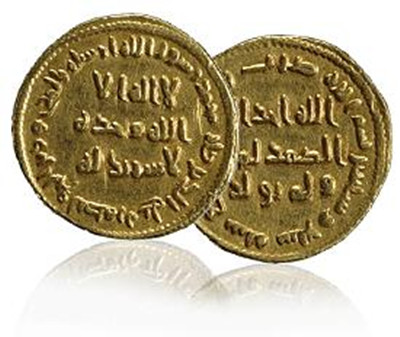And it appears on this coin. But this coin also tells us something else. If coins reflect the dominant power in a society, it's clear that the dominant power in this empire is now not the emperor but the word of God. Portraiture or figurative art has no place in the official documents of such a state. The tradition of placing the ruler on the coin, familiar across the Middle East since the days of Alexander, had been decisively abandoned. And the text-only coin remained the norm in all Islamic states until the First World War. Arabic, the language of God, inscribed on an Islamic coinage, became a fundamental tool for the integration and survival of the first Islamic state.
这也就是这枚硬币上的文字。此外,金币也表明,这一帝国的统治力量不是君王,而是真主。此后,帝国的官方文献上再也没有出现任何人像或写实艺术。 曾流行于整个中东地区的将帝王像置于货币上的传统始于—千年前的亚历山大时期,如今被废弃了。直到一战之前,这种只有文字的硬币形式 —直是伊斯兰世界的标准。而阿拉伯语,镌刻于货币之上的真主的语言,成为第一个伊斯兰王朝整合与生存的基本工具。
Abd al-Malik, Khalifah Allah, Deputy of God, Ninth Caliph and Ruler of the Faithful, died in 705. But the message proclaimed on his coins of a universal empire of faith still resonates strongly.
公元705年,阿卜杜勒马利克,这位真主使者的继承人、安拉的代理人、第九代哈里发和信徒的领路人去世了。但在这个以信仰为基础的帝国里,由他镌刻在货币上的信息至今仍影响深远。
Today there is no caliph-long claimed by the Turkish sultans, the office was abolished in 1924. In fact, a universally accepted caliph has always been a rare thing, but the dream of a single Islamic empire-a caliphate-remains potent in the modern Islamic world. We asked the social anthropologist Professor Madawi al-Rasheed to comment:
如今的世界上已没有哈里发了。这个头衔长期以来由土耳其的苏丹继承,1924正式废止。在历史上得到广泛承认的哈里发极少。但建立一个统一的哈里发帝国的梦想在现代的伊斯兰社会仍极有号召力。 我曾询问过社会人类学家马达维?拉西德对这一点的看法:
"Muslims today, at least some sections of the Muslim community worldwide, aspire to this ideal of the caliphate as the embodiment of the Muslim community.
今天的穆斯林,至少世界穆斯林社区中的某部分穆斯林,十分渴望哈里发国家的理想能实现于现实中的伊斯兰社会。













